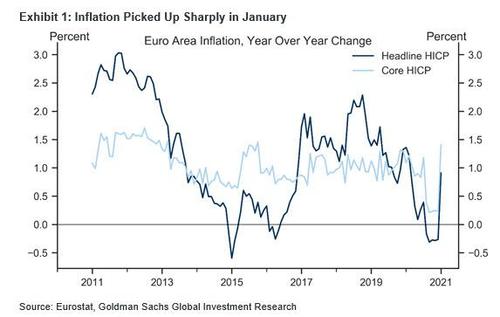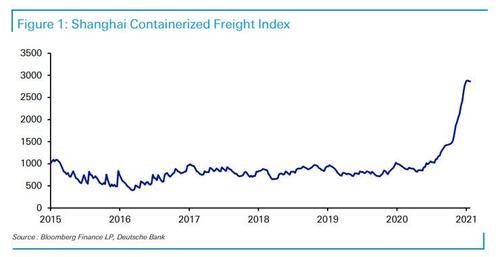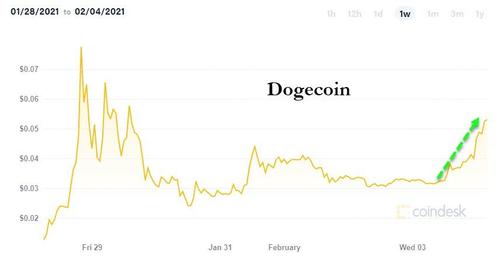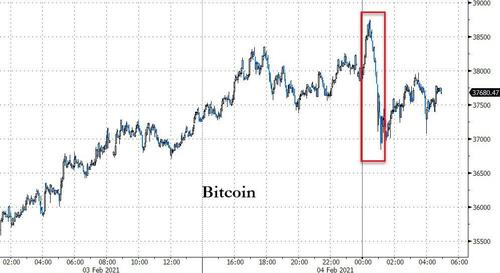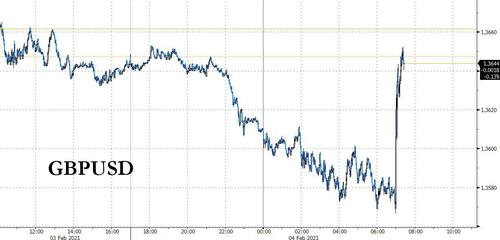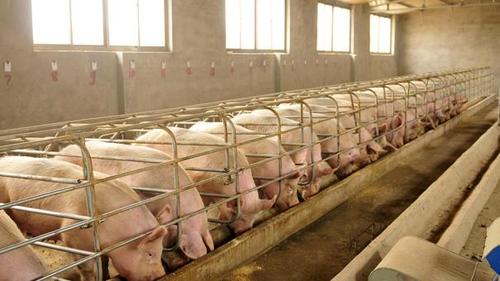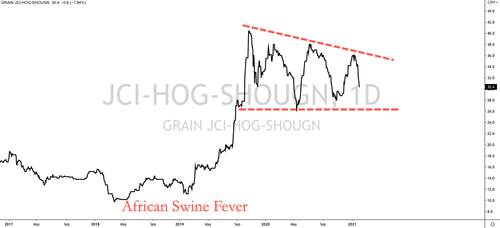Global markets were flat, and European stocks and US equity futures unchanged, struggling to eek out a fourth day of gains on Thursday as a rising USD and rising bond yields refocused attention on inflation and normalising economies. At 7:30 a.m. ET, Dow e-minis were up 4 points, S&P 500 e-minis were up 3.75points, or 0.1%, and Nasdaq 100 e-minis were up 40.5 points, or 0.29%.
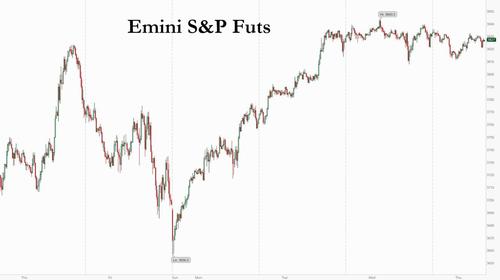
With the WallStreetBets/Reddit retail short squeeze tumult having eased this week, markets were back in their comfort zone of corporate earnings, economic data and central bank meetings. US stocks closed slightly higher on Wednesday, with Google shares hitting a record high following strong quarterly results. All the three major indexes have bounced back sharply this week as investors monitored talks over the next round of fiscal stimulus and as a recent buying frenzy driven by social media appeared to stall following a bout of market volatility last week. Meme names rose, with GameStop up 3.9%, while AMC added 2.6% in premarket trading ahead of U.S. Treasury Secretary Janet Yellen’s meeting with financial regulators later in the day to discuss the recent market volatility.
Meanwhile, the bogeyman of rising inflation is back as hopes that the COVID pandemic can be brought to heel by extensive vaccination programmes, combined with expectations of unswerving global economic stimulus, has begun to see bond market focus returning to rising debt and possible inflation. The 10Y US yield rose just shy of 1.15% this morning, as traders renew reflation bets amid signs the economic recovery is gathering pace and the imminent passage of $1.9 trillion of pandemic aid by U.S. lawmakers. Friday’s payroll report may provide fresh impetus after the private sector added more jobs than forecast in January.
“These numbers give investors limited reason to fade rates weakness at this stage,” strategists at Mizuho International Plc including Peter Chatwell wrote in a Thursday report. The “momentum” pushing up rates could take the 10-year Treasury benchmark yield to 1.2% and the long-bond to 2% before stalling, they predicted.
In central bank moves, the pound erased a loss as Bank of England policymakers said inflation is expected to rise sharply, while voting to keep the key rate at 0.1% and the bond-buying target unchanged.
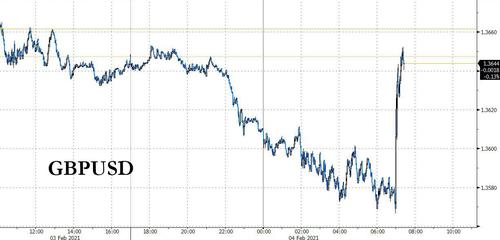
“The BoE will maintain a quite cautious tone,” said Silvia Dall’Angelo, a senior economist at fund management firm Federated Hermes, adding it was likely that the bank would talk about negative rates. “But at this stage there is very little appetite to use this measure.”
European stocks erased an earlier gain amid a mixed bag of company results. Deutsche Bank reversed an earlier gain after the German lender reported its first annual profit in six years, and Unilever slumped after margins missed estimates on restructuring charges.
Markets were also softer in Asia where stocks fell overnight, their first decline this week, weighed down by drops in technology companies. MSCI’s ex-Japan Asian-Pacific index fell 0.6%, led by 1.3% and 0.4% drops in South Korea and China. Japan’s Nikkei lost 1% as it ended a three-day winning streak. Rising Chinese short-term interest rates kept risk appetite low, though analysts also noted position adjustments before the Lunar New Year starting next week are likely to play a role too. Higher interest rates have raised worries that Chinese policymakers may be starting to shift to a tighter stance to rein in share prices and property markets.
“There’s persistent speculation that the Chinese authorities may want to tighten its policy,” said Wang Shenshen, senior strategist at Mizuho Securities.
Asian stocks Samsung Electronics was the biggest contributor to the MSCI Asia Pacific Index’s drop, falling after Qualcomm warned it was struggling to meet rebounding demand for chips. TSMC, SK Hynix and Xiaomi were also among the biggest drags. South Korea led declines among national benchmark gauges. Japanese stocks dropped, with losses in personal-care products maker Kao contributing most after it gave guidance that trailed analyst estimates. Sony shares surged to their highest level since 2000 on positive earnings. India bucked the trend as its benchmark stock gauge extended a rally to a record high after the government unveiled a massive annual spending plan.
With no notable fireworks overnight, markets have calmed in the past few days with the Cboe Volatility index slipping to its lowest levels in over a week. As the retail trading frenzy seen last week faded, stock prices of GameStop and other social media favorites have steadied, although cryptocurrency Ethereum has been on a tear ahead of the introduction of futures contracts next week.
In rates, treasuries were narrowly mixed across the curve, yields within 1bp of Wednesday’s closing levels, after paring declines that pushed 30-year above its March 2020 high. Treasury 10-year yields around 1.14% after nearly reaching 1.15% during Asia session, while 30-year took out the March highs, moves that were pared during European morning. Gilt yields shot higher after BOE rate decision, buoying U.S. yields slightly. Germany’s 30-year government bond yield on Thursday was almost back in positive territory for the first time since September. The gap between two- and 10-year U.S. Treasury yields at more than 100 basis points is now the widest in almost three years.
In FX, the dollar hit a near-three-month high versus the Japanese yen of 105.19. The euro lost 0.4% to $1.1989, having already hit a two-month low overnight below 1.20, failing to capitalize on improved sentiment in Italy after former European Central Bank chief Mario Draghi accepted the task of trying to form a new government in the country. The pound rebounded from the biggest decline in three weeks after the BOE cautioned that much higher inflation may be coming, pouring cold water on expectations for negative rates. The yen fell a seventh day versus the dollar, the longest losing streak since 2016.
In commodities, oil continued its ascent with OPEC+ saying it will keep pushing to quickly clear the surplus left behind by the pandemic. Brent approached $60 a barrel after OPEC and its allies extended production cuts. Silver settled further into a calmer trading pattern after the wild ride inspired in part by a retail-investor buying frenzy, while gold headed for the lowest close in two months. Gold fell 1% to $1,810 per ounce.
“OPEC have come in and said they are looking to remove the supply but the main driver is markets are starting to price in demand recovery, especially from emerging markets,” said Legal & General Investment Management’s Justin Onuekwusi.
U.S. companies are on track to post earnings growth for the fourth quarter of 2020, data from Refinitiv showed on Wednesday, which would defy expectations for profits to drop 10% due to the pandemic.
Market Snapshot
- S&P 500 futures up 0.1% to 3,825.75
- Stoxx Europe 600 little changed
- MXAP down 0.6% to 210.99
- MXAPJ down 0.6% to 712.38
- Nikkei down 1.1% to 28,341.95
- Topix down 0.3% to 1,865.12
- Hang Seng Index down 0.7% to 29,113.50
- Shanghai Composite down 0.4% to 3,501.86
- Sensex up 0.8% to 50,678.05
- Australia S&P/ASX 200 down 0.9% to 6,765.50
- Kospi down 1.3% to 3,087.55
- Brent futures up 0.4% to $58.71/bbl
- Gold spot down 1.1% to $1,814.77
- U.S. Dollar Index up 0.3% to 91.44
- German 10Y yield fell 0.6 bps to -0.467%
- Euro down 0.4% to $1.1988
Top Overnight News from Bloomberg
- Of the five countries leading the fight against Covid-19, all but one saw their currencies gain versus the dollar in January, according to a Bloomberg study of the 15 biggest economies with publicly available vaccination and infection data
- The U.K. has passed the peak of its latest wave of the coronavirus pandemic, officials said, as the country reached the milestone of vaccinating 10 million people, about 15% of the population
- Treasury Secretary Janet Yellen’s plan to oversee a snap meeting of top regulators to discuss recent market volatility signaled the new administration’s focus on consumer financial protection after years of emphasis on deregulation
- Deutsche Bank AG closed out a bumper year for trading with a result that beat most Wall Street peers, handing Chief Executive Officer Christian Sewing the first annual profit in six years as he leans increasingly on the investment bank
A quick look at global markets courtesy of Newsquawk
Asian equity markets were mostly lower following a flat lead from the US where participants were tentative amid mixed earnings and as focus remained on stimulus plans with some expectations tempered regarding the stimulus amount after President Biden suggested he is willing to limit the eligibility for stimulus checks but won’t budge on the size of payments at USD 1,400 and there were also comments from a Biden adviser who speculated that the final stimulus size could be USD 1.3tln. ASX 200 (-0.9%) was dragged lower by underperformance in defensive sectors and with the mood also soured after fresh COVID-19 measures were announced in Victoria state following 3 new infection cases, while mixed trade data showed a decline in Imports which suggested weaker domestic demand. Nikkei 225 (-1.1%) succumbed to negative mood which overshadowed encouraging blue-chip earnings that lifted Hitachi, Nomura Holdings and Sony shares after they all registered profit growth. Hang Seng (-0.8%) and Shanghai Comp. (-0.4%) were choppy after the PBoC opted for 14-day reverse repos in its open market operation for the first time this year ahead of next week’s Lunar New Year holidays, although this still amounted to a net neutral position on the day. Tensions between US and China also lingered after the US State Department noted it is deeply disturbed by allegations of rape and sexual abuse against women at the Uighur camps in Xinjiang and called for China to allow independent investigations, while there were also comments from Commerce Secretary nominee Raimondo that she sees no reason why Chinese companies including Huawei and ZTE should not remain on the blacklist. Nonetheless, there were a few bright spots with Ping An Insurance the biggest gainer in Hong Kong after it topped earnings forecasts and with Alibaba kept afloat after Ant Financial Services reached an agreement with Chinese regulators on a restructuring plan to become a financial holding company, and large oil names were also boosted following recent upside in the underlying commodity price. Finally, 10yr JGBs were subdued after the continued bear-steepening in USTs but with downside stemmed amid losses in stocks, with JGBs also not helped by mixed results at the MOF 30yr auction which registered a larger b/c due to a decline in accepted prices.
Top Asian News
- Ant and China Banks Are Reining In Joint Loans to Consumers
- Kuaishou Surges 181% in Hong Kong Gray Market Trading
- KAZ Minerals Buyout Offer Increased After Investor Pressure
European equities kicked off the session mostly firmer (Eurostoxx 50 +0.1%) in what has been a busy morning of corporate updates across the region. From a macro perspective, focus remains on the progress of vaccinations and subsequent impact on reopening efforts, whilst US stimulus talks have taken an increased focus in recent sessions as the euphoria surrounding last week’s WallStreetBets short squeeze dissipates. Focus for stimulus will in the large-part centre around the overall price tag of the legislation, however, a more nuanced view of the matter will consider what concessions the Biden camp is willing to make (e.g eligibility criteria for stimulus checks) in order to navigate Congressional obstacles presented by the GOP and from within certain parts of his own party. Back to Europe, the modest divergences in the performance of regional indices is largely attributable to corporate updates with the AEX (-0.3%) softer on account of disappointing earnings from Unilever (-4.6%) who sit at the foot of the Stoxx 600 and has prompted underperformance in the Personal & Household Goods sector. Elsewhere, from a sectoral standpoint, telecom names are also lagging peers amid post-earnings losses from Nokia (-2.0%) with the Co. unable to counter some of the retail-led swings in its share price despite a relatively positive report. Additionally for the sector, opening gains in BT (now flat) shares proved to be short-lived. Deutsche Bank (-1.6%) also staged a turnaround despite opening higher to the tune of 3.5% after reporting its first profit since 2014. Further pressure for the banking sector has also been presented by losses in Commerzbank (-2.8%) after the Co. reported a FY20 net loss of EUR 2.9bln and finalised plans for a reduction in 10k full time jobs. Elsewhere in Germany, Bayer (+5.1%) have lent a helping hand to the DAX after striking a USD 2bln agreement to resolve future legal claims over future Roundup cancer claims. Shell (-1.3%) shares are modestly lower on the session after announcing a 71% decline in profits for 2020 as the impact of the pandemic sapped global energy demand.
Top European News
- Shell Deepens Big Oil’s Disappointment With Earnings Miss
- Nokia Sees Revenue Drop in 2021 in Fight for Market Share
- SoftBank- Backed Auto1 Soars in Debut After $2.2 Billion IPO
- Deutsche Bank’s DWS Rakes in Most Client Cash Since Listing
In FX, The broader Dollar and index continues to gain ground above 91.000 in early European trade after experiencing defensive inflows overnight, whilst notching the current peak just shy of 91.500 as EUR/USD dipped under the 1.2000 mark for the first time this year before trundling lower. Fundamental news-flow has been scarce in the European morning thus far. On the State-side stimulus front, as expected the House voted to pass the budget plan in a bid to fast-tracks President Biden’s stimulus proposal, but some see a more moderate final package. Looking ahead for the Dollar, barring any major fundamental catalysts, the BOE is likely to take centre stage in the run-up to the weekly IJCs – although these metrics could be overlooked as it falls outside the survey period for tomorrow’s jobs report. From a technical standpoint, upside levels include the psychological 91.500 mark ahead of the 100 DMA at 91.852, whilst to downside levels see yesterday’s 90.988 low alongside the 21 and 50 DMAs at 90.491 and 90.478 respectively. Over to the single currency, EUR/USD ebbs further sub-1.2000 after earlier tripping some stops below the figure as it inches closer towards the 100 DMA (1.1965) as eyes remain on the Italian political limbo, whilst some also note of increased demand for EUR/USD downside protection via shorted-dated put strikes, with many reportedly at 1.1900. Note, the pair eyes some EUR 1bln in OpEx between 1.2000-05 alongside EUR 2.7bln between 1.2035-50.
- GBP – Sterling succumbs to the Buck in the run up to the BoE policy announcement (full preview available on the Newsquawk Research Suite) where eyes will be fixated on commentary on the feasibility of NIRP for the banking sector if required, although the immediacy of such policy is likely to be downplayed by the MPC. Meanwhile, markets currently pencil in incremental negative rates for August. Cable has descended from its 1.3683 high, through its 21 DMA (1.3645) to trade sub-1.3600 as keeps its 50 DMA (1.3540) on the radar.
- AUD, NZD, CAD – The non-US Dollars portray varying degrees of resilience vs the Dollar amid possible impetus/cushioning stemming from the commodities complex. AUD/USD outpaces its peers despite lacklustre trade data overnight, with some also citing a retracement of the RBA-induced downside earlier in the week, although firmer copper and iron ore prices could be underpinning the currency. AUD/USD resides just above 0.7600 after finding mild support at its 50 DMA (0.7614), with clean air seen on either side aside from the psychological figures. The Loonie has dipped probes 1.2800 but the Dollar headwinds have been diminished as crude prices remain elevated. The Kiwi straddles around 0.7200 as the AUD/NZD cross hovers around 1.0600. Technicians will be eyeing the a couple of downside DMAs in the NZD/USD including the 21 DMA (0.7185) and the 50 DMA (0.7140).
- CHF, JPY – Again another Dollar story with USD/JPY edging further above 105.00 after surpassing this week’s prior high of 105.17 with the 200 DMA 105.57 up ahead. For reference, the pair sees around USD 1.4bln in OpEx at strike 105.00 heading into today’s NY cut. Subsequently, USD/CHF has reclaimed a 0.9000+ handle and topped the 100 DMA (0.9013)
In commodities, WTI and Brent front month futures remain somewhat uneventful as the complex takes a breather following its recent run higher as vaccine hopes and OPEC+ proactivity keep prices elevated. On the OPEC front, the meeting and outcome were as planned and no decision was made for next month’s output. The key date to watch would be the March 3-4th confabs as producers re-diagnose the crude market and decide on the next step – although, this risks forming another rift among the producers as higher prices tempt more output whilst the near-term outlook remains clouded. WTI and Brent both reside in tight ranges around USD 56/bbl and USD 58.75/bbl respectively. Elsewhere, spot gold and silver continue to see losses as the firmer Dollar weighs on precious metals. Spot gold hovers just above USD 1800/oz (vs high USD 1834/oz) whilst spot silver trades sub-26.50/oz (vs high. 26.92/oz). Turning to base metals, copper prices were firmer overnight amid US stimulus hopes, with Shanghai copper closing higher by some 1.2%. However, LME copper waned off best levels as the firmer Dollar and indecisive risk tone hampered upside. Meanwhile, Dalian iron ore futures soared around 5% amid tailwinds from Brazil’s Vale stating its 2020 output was subdued.
US Event Calendar
- 8:30am: Jan. Initial Jobless Claims, est. 830,000, prior 847,000; Continuing Claims, est. 4.7m, prior 4.77m;
- 8:30am: 4Q Nonfarm Productivity, est. -3.0%, prior 4.6%; Unit Labor Costs, est. 4.0%, prior -6.6%
- 10am: Dec. Cap Goods Orders Nondef Ex Air, est. 0.6%, prior 0.6%; Cap Goods Ship Nondef Ex Air, prior 0.5%
- 10am: Dec. Durable Goods Orders, est. 0.2%, prior 0.2%
- 10am: Dec. Factory Orders Ex Trans, prior 0.8%; Dec. Factory Orders, est. 0.7%, prior 1.0%
DB’s Jim Reid concludes the overnight wrap
Following an incredibly strong start to the week, the global rally in risk assets showed signs of waning yesterday, with the S&P 500 ending the session up just +0.10%. However under the surface there was a return of the pro-cyclical trade, which coincided with steepening yield curves, as Energy (+4.27%) and Bank (+1.73%) stocks were among the best performing industries. Even the Reddit stocks seemed to calm down with GameStop moving just +2.68%, after not having a single-digit percentage price move in over a week. While some trades like AMC (+14.2%) still saw outsized moves, others such as Nokia (+3.75%), Blackberry (+3.90%) and Silver (+0.79%) also calmed down. It was a similar story of moderate moves in the other major indices, with the NASDAQ broadly unchanged (-0.02%) and Europe’s STOXX 600 (+0.33%). Oil prices did rise to their highest level since the pandemic started though as Brent crude rose +1.74% to $58.46 and WTI rose +1.70% to $55.69 – which is its highest closing price in just over a year. This came on the back of a communique from the OPEC+ which said that it will keep pushing to quickly clear the oil surplus left behind by the pandemic.
Similar to oil, Italian assets surged after former ECB President Mario Draghi accepted a mandate from President Matteralla to form the next Italian government, an outcome that investors have taken extremely well. By the close, the FTSE MIB had risen +2.09% to far outpace the other European bourses, and the spread of 10yr Italian yields over bunds tightened by -8.9bps to their narrowest level in nearly 5 years. Indeed, that’s the biggest one-day decline in spreads since June, back when the ECB announced a €600bn expansion of their asset purchases. The task now for Draghi will be to win support from enough lawmakers to form a new government, since a government requires a positive vote of confidence in parliament. But according to our European economists (link here) the pressure on politicians to compromise is extremely high following the President’s message, and it would be quite difficult for the parties in the outgoing government to say no to a Draghi government. As a result, they think it’s more likely than not that Draghi is able to get majority support. How long such a government lasts is another question our economists try to answer in their note.
It was a different story outside of southern Europe however, as sovereign bond yields continued to move higher on both sides of the Atlantic, with those on 10yr bunds up +2.5bps to their highest level in nearly 6 months. In the US, Treasury yields also climbed further, with those on 10yr debt rising +4.1bps to 1.137%, as 30yr yields reached their highest level since the pandemic began, at 1.93%. The moves came as President Biden told House Democrats yesterday that he was more concerned that too little would be spent rather than too much when it came to economic relief. Democrats voted to open budget reconciliation measures in both chambers of Congress yesterday, with party leaders again asking for Republican support while signalling that they are willing to pass the majority of the stimulus measures through a party line vote if necessary.
Against this backdrop, the 2s10s yield curve, which is one of our favourite cyclical indicators, steepened further, reaching a 3-year high of 102bps, whilst the 5s20s curve reached its highest level in almost 5 years and the 5s30s steepened to levels last seen in October 2016. Over the past few months when US yields climb near pandemic highs, the question of yield curve control always seems to be raised. Fed Governor Bullard this time fielded the question and responded that the current policy is “in good shape” and that there is no need to adjust, while also saying there was quite a way to go before curtailing asset purchases as well.
Overnight the recent equity rally has unwound a little with the Nikkei (-1.02%), Hang Seng (-1.57%), Shanghai Comp (-1.26%), Kospi (-1.89%) and Asx (-0.87%) all down. Futures on the S&P 500 are down -0.26% as we type while the US dollar index is up +0.11%. Weighing on sentiment a touch are hawkish comments from the US Commerce Secretary nominee Gina Raimondo on restricted Chinese companies. She said that she knows of “no reason” why Huawei, ZTE and other Chinese companies shouldn’t remain on a restricted trade list thus suggesting that the new administration will likely continue with a hard-line stance on China. In other overnight news, the meeting between Treasury Secretary Yellen and US financial regulators will take place today on the recent bout of volatility in the markets.
Data yesterday showed that inflation in the Euro Area in January rose by more than expected, with the flash estimate showing prices were up +0.9% on the previous year (vs +0.6% expected), bringing to an end 5 successive months in which the Euro Area had been in deflationary territory. Core inflation also saw a similarly sharp rise, climbing to +1.4% (vs. +0.9% expected), albeit these jumps were driven by a number of one-off factors like the end of the temporary VAT cut in Germany. That said, in spite of these temporary factors, there were further signs that market expectations of longer-term inflation were also moving higher, with the 5y5y forward inflation swaps for the Euro Area up +6.1bps to 1.38%, their highest level in over a year. On top of this, both German and Italian 10yr breakevens were at a fresh 2-year high.
Speaking of inflation, our chart of the day yesterday (link here ) looked at the massive rise in shipping rates over recent months, with the Shanghai Containerized Freight index at more than triple its levels in May last year, and other freight indices are showing much the same picture. There are a number of reasons why this has happened, from Covid-related disruption, a more rapid bounceback in economic growth, along with the 3 major shipping alliances becoming far more disciplined around capacity. The big question will be whether this portends a larger rise in inflation this year as pent-up demand and excess savings are released. One thing I learnt in compiling the note is that commercial airlines are used for a lot of freight. So if economies increasingly re-open but commercial travel is restricted on fears of virus mutations being imported, then we could have more supply chain issues and more upward pressures on prices.
In terms of the latest on the pandemic, the World Economic Forum announced that they would be moving their annual meeting to August, which had previously been scheduled for late May. Meanwhile in the UK, it was confirmed that the number of people who’d received a first dose of the vaccine had now surpassed 10 million, while the 7-day case average fell to a 7-week low yesterday of 22,395. Israel, who already lead the world in vaccinations per capita, announced they will be widening availability to all people over the age of 16 starting today. Meanwhile in the US, New York City announced that taxi drivers and restaurant workers are now eligible for the jab. This comes just ahead of limited indoor dining reopening later this month. Meanwhile other states in the North-eastern US continue to loosen restrictions with New Jersey expanding their own indoor dining quotas and allowing restaurants to remain open longer as the Governor cited improving hospitalisations and case count data as the reason for the changes.
Moving onto vaccines, AstraZeneca and the University of Oxford said overnight that they have started looking at how to re-engineer their coronavirus vaccine to defeat new mutations. The University of Oxford is also undertaking another trial that will combine vaccines from Pizer/BioNTech and AstraZeneca to see whether two shots of different vaccines produce better or worse results than two doses of the same product. The university will begin recruiting 820 participants over 50 years of age across eight UK sites this week. A successful outcome from the study will help manage supplies better.
Staying on the UK, one of the highlights later today will be the first BoE policy decision of 2021 at 12:00 London time. In terms of what to expect, our UK economists (link here) write that the MPC is likely to deliver a dovish message, and they see the Bank formally including negative rates in its toolkit, which should lower the bar for further rate cuts. However, no policy changes are expected at this stage, with a unanimous vote from the MPC to keep rates unchanged. Beyond this meeting, their base case is that the MPC will stay on hold for the rest of this year, though risks remain from a longer-than-expected lockdown or a disappointing recovery.
Finally on the data front, the final Euro Area composite PMI for January was revised up slightly from the flash reading to 47.8 (vs flash 47.5), while the UK also saw an upward revision to 41.2 (vs. flash 40.6). Over in the US, the ISM services index for January rose to a stronger-than-expected 58.7 (vs. 56.7 expected), which is its strongest level since February 2019. Separately, ahead of tomorrow’s jobs report, the ADP’s report of private payrolls also rose by a much stronger-than-expected +174k in January (vs. +70k expected).
To the day ahead now, and the aforementioned Bank of England decision will be one of the highlights, while the ECB will also be publishing their Economic Bulletin. Other central bank speakers include the ECB’s Hernandez de Cos, along with the Fed’s Kaplan and Daly. Data highlights include the January construction PMIs from the UK and Germany, along with Euro Area retail sales for December. Meanwhile in the US, we’ll get the weekly initial jobless claims and December factory orders. Finally, earnings releases include Gilead, Merck & Co., T-Mobile US, Bristol Myers Squibb, Philip Morris International and Ford.
